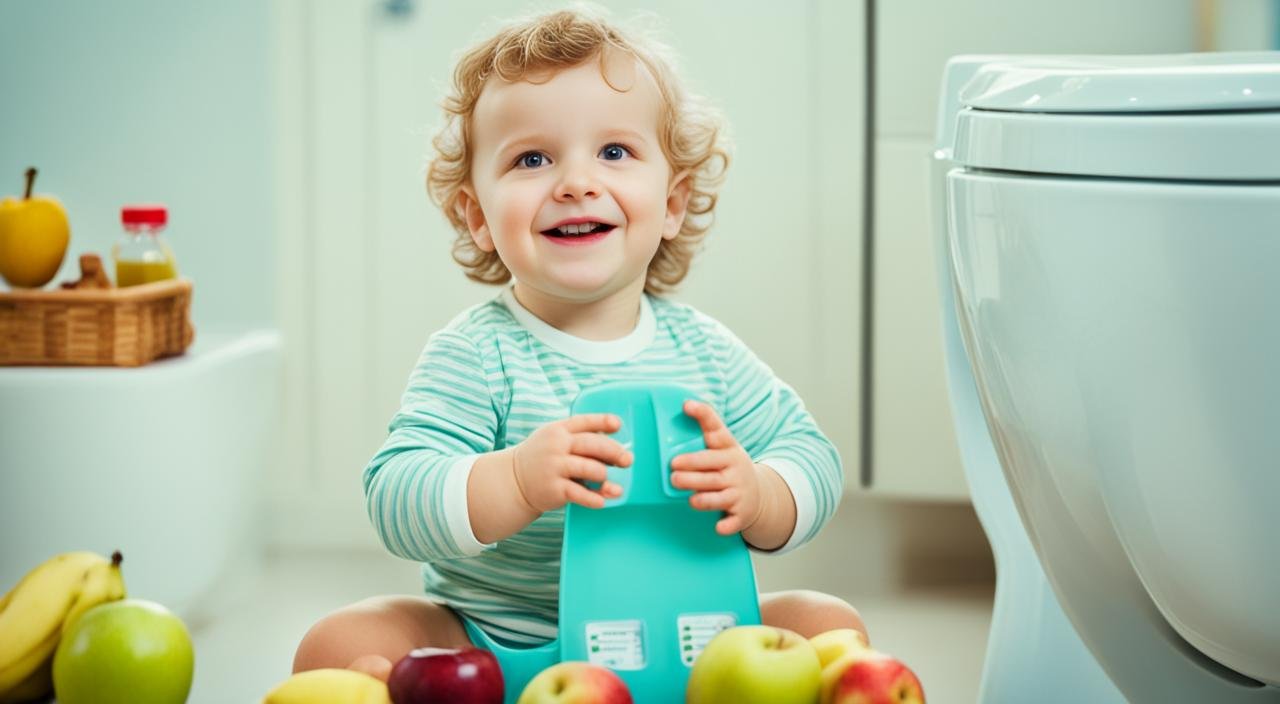Constipation is a common issue in children, affecting approximately 30–35% of kids at some point. It can cause discomfort and pain, making it essential to find effective solutions to help your child. Recognizing the signs of constipation and implementing safe and easy remedies can bring relief and promote healthy bowel movements.
Key Takeaways:
- Constipation is a common problem in children, affecting about one-third of them.
- Recognizing the signs of constipation, such as infrequent bowel movements and hard stools, is crucial for early intervention.
- Effective home remedies for child constipation include abdominal massage, increasing water intake, and adding fiber-rich foods.
- Reduce dairy intake and create a stress-free environment during potty breaks.
- Always consult with a healthcare provider for guidance before using over-the-counter medications or treatments.
Recognizing Signs of Constipation in Babies and Children
Recognizing constipation in babies and young children can be challenging, as they may not be able to communicate their symptoms effectively. However, understanding the signs can help you identify and address constipation in your little ones.
Signs of Constipation in Babies:
- Pellet-like bowel movements
- Difficulty passing stools
- Crying during bowel movements
- Hard and dry stools
- Less frequent bowel movements
These symptoms indicate that your baby may be struggling with constipation. If you notice any of these signs, it’s important to provide relief and support their digestive health.
Signs of Constipation in Toddlers:
- Pellet-like or unusually large stools
- Hard stomach
- Abdominal swelling
- Traces of blood on toilet paper
Toddlers may experience similar symptoms to babies, but they might also have additional signs such as large stools and abdominal swelling. These indicators should be addressed promptly to ease their discomfort.
Signs of Constipation in Older Children:
- Stomach pain
- Traces of liquid in their underwear
- Pain during bowel movements
Older children may verbalize their discomfort, complaining of stomach pain and experiencing pain during bowel movements. It’s important to listen to their concerns and take appropriate steps to alleviate constipation.
By recognizing these signs, you can identify constipation in babies and children and take necessary measures to provide them with relief and support their digestive system. In the next section, we will explore home remedies that can help alleviate constipation in babies and toddlers.
Home Remedies for Baby and Toddler Constipation

When your baby or toddler is constipated, there are several home remedies you can try to provide relief. These remedies focus on increasing fiber intake and promoting regular bowel movements. Remember that it’s important to consult with your pediatrician before trying any new remedies or treatments.
Increasing Water Intake
Ensuring your child is adequately hydrated is crucial for preventing and relieving constipation. Offer your baby or toddler small sips of water throughout the day to keep them hydrated. This helps soften stools and makes them easier to pass. Be mindful that babies under 6 months old should only consume formula or breast milk and not other fluids.
Adding More High-Fiber Foods
Introducing high-fiber foods into your child’s diet can help promote regular bowel movements. Some examples of high-fiber foods suitable for babies and toddlers include:
| Food | Fiber Content per 100g |
|---|---|
| Apples | 2.4g |
| Pears | 3.1g |
| Peas | 5.5g |
| Prunes | 2g |
| Bananas | 2.6g |
These fiber-rich foods can help add bulk to the stool and make it easier to pass. Start by introducing small amounts and gradually increase the portion size as tolerated.
Reducing Rice Cereal Consumption
If your baby consumes rice cereal, reducing the amount they consume may help relieve constipation. Rice cereal is low in fiber and can contribute to hard, dry stools. Consider substituting it with oatmeal or other whole-grain cereals, which are higher in fiber.
Using Infant Glycerin Suppositories
In cases where immediate relief is needed, infant glycerin suppositories can be used under the guidance of a healthcare professional. These suppositories help stimulate bowel movements and provide temporary relief from constipation.
Remember, if home remedies do not improve your baby or toddler’s constipation symptoms, it’s crucial to consult with your pediatrician for further guidance and medical treatment options.
Tips for Relieving Constipation in Older Children
When it comes to older children, constipation remedies may vary from those for younger children. Here are some effective tips to help relieve constipation in older kids:
- Increasing Water Intake: Encourage your child to drink an adequate amount of water throughout the day. This helps soften stools and promote regular bowel movements.
- Offering Glycerin Suppositories: If your child is experiencing severe constipation, you can consider using gentle glycerin suppositories to provide immediate relief. However, it’s important to consult with a healthcare professional before using any suppositories.
- Incorporating Fiber-Rich Foods: Include more fiber-rich options in your child’s diet, such as fruits, vegetables, and whole grains. Fiber helps add bulk to the stool and improves bowel movements.
- Administering Fiber Supplements: In some cases, healthcare professionals may recommend fiber supplements to assist with constipation. These can be particularly helpful if your child’s diet is lacking in fiber.
- Encouraging Physical Activity: Engage your child in regular physical activities like riding a bike, playing sports, or walking the dog. Physical activity stimulates intestinal contractions and helps regulate bowel movements.
It’s important to remember that laxatives or enemas may be considered for children over 4 years old but should only be used under the guidance of a healthcare professional. Consulting with a healthcare provider is crucial before starting any new treatment or medication for your child.
By following these tips and incorporating healthy habits into your child’s routine, you can help alleviate constipation and promote better digestive health.
Conclusion
Managing child constipation is crucial for supporting your child’s digestive health and overall well-being. By recognizing the signs of constipation and implementing appropriate home remedies, you can provide relief to your child. However, it’s important to consult with a healthcare professional for personalized advice and treatment options.
Home remedies such as increasing water intake, incorporating high-fiber foods into their diet, and gentle abdominal massage can help alleviate constipation in children. These solutions are safe and easy to implement. Additionally, seeking medical advice when needed and following the guidance of a healthcare professional can ensure effective management of constipation.
Remember, every child is unique, and there may be underlying causes or medical conditions that require specific treatment. Consulting with a healthcare provider allows for personalized insights and appropriate medical interventions if necessary. By working together and following these child constipation solutions, you can help your child find relief and maintain a healthy digestive system.
FAQ
How can I help my child with constipation?
You can help your child with constipation by trying safe and easy home remedies. Some options include abdominal massage, natural laxatives like prunes and apples, increasing water intake, and increasing fiber in their diet. It’s important to consult with your child’s healthcare provider before giving them any over-the-counter medication or treatment options.
How can I recognize constipation in babies and children?
Signs of constipation in babies include pellet-like bowel movements, difficulty passing stools, crying during bowel movements, hard and dry stools, and less frequent bowel movements. Older children may complain of stomach pain, have traces of liquid in their underwear, and experience pain during bowel movements. Pay attention to any changes in your child’s bowel movements to recognize constipation.
What are some home remedies for baby and toddler constipation?
Home remedies for baby and toddler constipation include increasing water intake, offering fruit juice (such as apple juice, prune juice, or pear juice), adding more high-fiber foods to their diet (such as apples, pears, peas, prunes, and bananas), reducing the amount of rice cereal they consume, and using infant glycerin suppositories for immediate relief. Consult with a pediatrician if home remedies do not improve the constipation symptoms.
What are some tips for relieving constipation in older children?
Tips for relieving constipation in older children include increasing water intake, offering a gentle glycerin suppository, incorporating more fiber-rich options into their diet (fruits, vegetables, and whole grains), and encouraging physical activity. Laxatives or enemas may be considered for children over 4 years old but should only be used under the guidance of a healthcare professional.
How can I manage my child’s constipation?
Constipation in children can be effectively managed through home remedies and medical treatments under the guidance of a healthcare professional. Recognizing the signs of constipation, implementing appropriate home remedies, and seeking medical advice when needed are essential for supporting your child’s digestive health.





